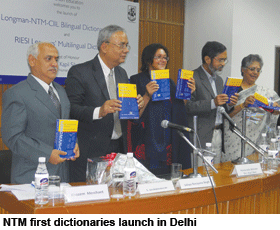The National Translation Mission (NTM, estb. 2008 on recommendation of the National Knowledge Commission) released its first seven dictionaries — six bilingual tomes translating English words into Hindi, Bengali, Oriya, Kannada, Malayalam and Tamil, and a learner’s English which translates into four major south Indian languages: Tamil, Kannada, Telugu and Malayalam — on March 10 in New Delhi. This major translation project is being spearheaded by the nodal Central Institute of Indian Languages (CIIL), Mysore and the Regional Institute of English South India (RIESI), Bangalore, which have joined forces with Pearson Education under its Longman imprint for this PPP (public-private partnership) project.
 The translations are of 12,000 most frequently used words and phrases culled from the British National Corpus. While six of the dictionaries were released in March, another five (Gujarati, Marathi, Punjabi, Telugu and Urdu) are works in progress. According to Prof. S.N. Burman, director CIIL, the project will cover 11 more languages in its second phase so that all 22 vernacular languages listed in the Eighth Schedule of the Constitution are covered. NTM also plans to build up lexicon bases for the Santhali, Konkani, Marathi, Bodo and Sanskrit languages.
The translations are of 12,000 most frequently used words and phrases culled from the British National Corpus. While six of the dictionaries were released in March, another five (Gujarati, Marathi, Punjabi, Telugu and Urdu) are works in progress. According to Prof. S.N. Burman, director CIIL, the project will cover 11 more languages in its second phase so that all 22 vernacular languages listed in the Eighth Schedule of the Constitution are covered. NTM also plans to build up lexicon bases for the Santhali, Konkani, Marathi, Bodo and Sanskrit languages.
The genesis of the idea of developing translation tools for transcending language barriers, which impede knowledge transmission from one language to another, dates back to the economic-reforms era of prime minister P.V. Narasimha Rao (1991-96) with the promotion of Centre for Applied Linguistics and Translation Studies (CALTS) at the University of Hyderabad. However, the real seeds of this mammoth project were sown in 2006 when CIIL established its Lexical Build Project which got a boost in 2008 when the National Knowledge Commission stressed the potential of language translations emerging as an industry and playing a major role in education, creation and dissemination of knowledge.
“This is a first step of a long journey. One of our primary mandates is to translate 2,000 knowledge texts used in colleges and universities of 69 disciplines into 22 languages. For a start, we have acquired rights for 23 of them from publishers to be translated in different languages. The lexicon is an important translation tool — kind of a spring board to push mother tongues, many of which are threatened with extinction. The ultimate aim is to build a languages translation industry mobilising stakeholders (both private and public) and getting regional language publishers into the loop. They know how to reach readers,” says Dr. Aditi Mukherjee, project director of NTM.
Though the 22 languages listed in the Eighth Schedule are spoken by almost 96 percent of India’s population, the remaining 4 percent communicate in 600 dialects which are facing the threat of extinction. To address this issue, the government has taken depleting linguistic groups into account and is considering re-introduction of the Linguistic Survey of India after a century.
Language barriers and failure to address the issue have deprived millions of students countrywide of knowledge predominantly available in English. Moreover lack of reliable English to vernacular and vice versa dictionaries has been a major drag on inter-state commerce and the development of a seamless common market in post-independence India. Myopic language chauvinism and the uncertain status of English as a national language has cost the Indian economy at least 1-2 percent in terms of annual GDP growth. Against this backdrop NTM is a welcome and long overdue initiative which bodes well for Indian industry, academia and national integration.
Autar Nehru (Delhi)























